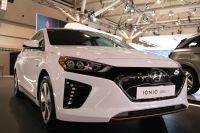
At the end of April, the Government of Canada announced that they will be providing an incentive to consumers for Zero-Emission Vehicles, or ZEVs starting May 1st 2019. With the growing popularity of ZEVs, it is understandable that many people want to reduce fuel emissions and think about the possibility of purchasing an electric vehicle. If you are wondering what classifies a vehicle to be ZEV, it means that the vehicle has to be either: battery-electric, plug-in hybrid electric, or hydrogen fuel cell. Over the years, something like a Tesla seemed unattainable to consumers. Even a model such as the Nissan Leaf is priced at the lower end of the $40,000’s. But, as the growing demand and popularity for ZEVs continue, manufacturers want to sell as many of these vehicles as possible, and it starts with the price of them.
The Government of Canada knows that offering incentives of up to $5000 for a new ZEV, will be attractive to potential customers and in the end, having more ZEVs on the road, reduces fuel emissions and will positively influence the economy.
So, there are two levels of incentives with regards to what the Government of Canada is offering.
- Battery-electric, hydrogen fuel cell, and longer range plug-in hybrid vehicles are eligible for an incentive of $5,000. (i.e. Chevrolet Volt, Chrysler Pacifica Hybrid, Ford Focus Electric etc.)
- Shorter range plug-in hybrid electric vehicles are eligible for an incentive of $2,500 (i.e. Audi A3 Sportback e-tron, Ford Fusion Energi, Hyundai Ioniq PHEV etc.)
To view the full list on the Government of Canada’s website, please click here.

This government offered incentive is a step in the right direction as Canada strives to meet its carbon emission reduction targets. As of September 2018, EV sales in Canada reached a high of almost 35,000 sales, up from 19,236 in 2017. (ref. Fleetcarma, 2018). Even though this is a huge jump, EV adoption in Canada continues to trail other industrialized countries around the world. In a country, such as the Netherlands (with a population of about 17 million vs. 37 million in Canada) sales of new electric vehicles are significantly higher. This could be attributed to the fact that their Electric Vehicle market has been supported by the Dutch Government. They offer consumers and businesses incentives to purchase Electric Vehicles. These incentives often resulted in tax savings of several thousand Euros on the purchase of a new electric vehicle. In 2018 alone, there were almost 146,000 EV sales in The Netherlands, and it is expected to grow to 200,000 sales by the year 2020. When the Dutch government first introduced these incentives, they were only available to businesses. However, the government knew that it was important to offer incentives to regular consumers if they wanted to grow the EV market in their country.

Canada seems to be following suit with other countries that are very supportive of the EV market. The great thing about this incentive, which became available May 1st 2019, is that it gives more people the opportunity to purchase a vehicle that was at one point way to expensive for the average consumer. We will just have to wait and see how much the sales will jump in the next few months after the Government of Canada offers this incentive.
Before you leave, please take a moment to participate in our survey on which Electric Vehicles (offered in Canada) that you might be inclined to buy. Click here.
CBC “The National” Story on Electric Vehicle Market in Canada:
Story credit: Eli Oszlak & McKenzie Dolan
Photo credit: McKenzie Dolan
